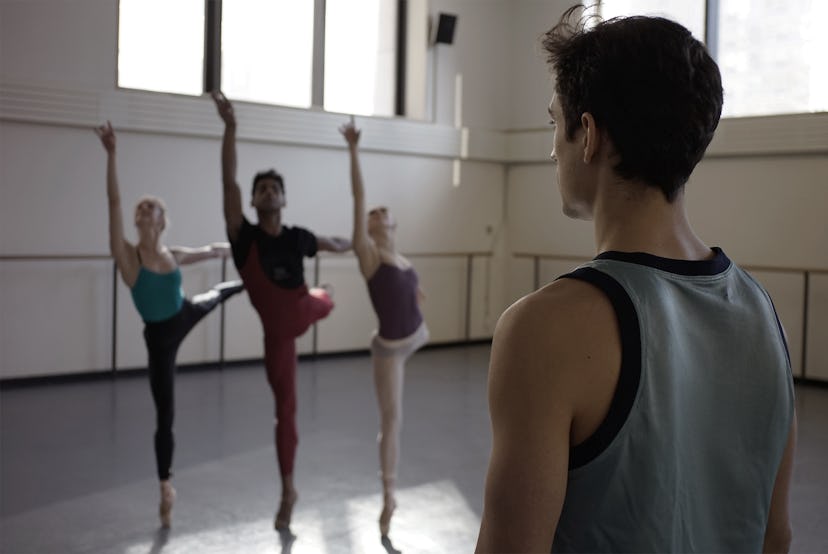Pecking Order

Ballet has become a source of increasing mass fascination thanks to films like Black Swan and celebrities like Sarah Jessica Parker, whose presence on the board of the New York City Ballet has initiated a slew of high profile fashion designer collaborations with the company. But the depth of work and range of talent that go into creating a ballet remain a mystery to the even some of the most seasoned balletomanes.
Enter Jody Lee Lipes’ thoughtful documentary, Ballet 422, opening this Friday. The film follows the rising star choreographer Justin Peck as he creates Paz de la Jolla, a work for the New York City Ballet that premiered during the winter 2013 season. The film showcases every aspect of the process, from rehearsals with the dancers to lighting design and even the dyeing of the costumes.
Peck, 27, a soloist at NYCB and, since last summer, its resident choreographer (only the second in history), has been dubbed the Next Big Thing by just about every dance critic, and thus proves a captivating subject. On the eve of another winter premiere at NYCB (he also has a world premiere at Miami City Ballet in March, featuring a set design by Shepard Fairey), the soft-spoken San Diego native discussed the film and his love of choreography.
At the time of filming, you were a young member of the corps and yet you were running rehearsals with three principal dancers, albeit young ones. How did that dynamic work? I think it helped in a way because I could really relate to them since I was still dancing and doing what they do in the studio as well. And those three principals I’ve known for a long time. Tiler Peck I’ve known since I was 15, and I was 25 when I made the film, so that’s a 10-year relationship. And I think they all really value the process of making something new so they were all just really game to work with me.
I was struck by the level of collaboration between you and the dancers. You were very open to their input and there was a real dialogue. I don’t know much about choreography: is that typical? Some of the most exciting moments are when I present the dancers with an idea and they can take that idea a bit further from where I initially imagined it to be. I get a real kick out of those moments, so I’m really open to having the input of the dancers. I definitely come in with a very developed vision, but I think coming in with that preparation allows me to be more spontaneous.
I think 99 percent of people don’t know what goes into making a ballet. Even people who are donating a lot of money to these projects or working within the New York City Ballet institution don’t really understand. There are a very select few that get it.
And you’re now a resident choreographer with the NYCB. What do you think when you watch this movie and how have you grown since? It was pretty early on in my relationship with NYCB as a choreographer, so it was a lot of figuring it out. I think NYCB has a tradition of having this sink or swim environment: they put young dancers out there in challenging roles and see how they do. It was similar for me. Looking back at the film, I looked like this kid standing in front of the room trying to run a rehearsal! There are quite a few awkward moments in the film where I have to figure out how far to push dealing with certain departments and people who work inside a very established and historic institution.
The one thing we don’t really get in the film is your personal background. At what point in your dance journey did choreography step in for you? I was always interested in exploring it from the point when I first moved to New York, which was when I was 15 and I started to become exposed to the work. I saw what choreography was as an art form and its relationship to music. And so that kind of sparked my interest. A first I thought I should focus on my dancing because that’s the natural progression but it was this itch that wouldn’t go away. So when I was 20 I made my first venture into choreography and I haven’t stopped since then. As soon as I finish one, I’m onto the next. And that’s the best way to learn.
And you’re still dancing, now as a soloist. How do you maintain that balance and creatively speaking, is one becoming more dominant for you? Choreographing is my true love. But dancing and choreographing can mutually benefit each other—there’s a lot for me to learn about ballets in our repertory through dancing them. I’m eager to keep performing new works and exploring new works and learning them, but on a physical level it’s really hard to switch back and forth. It can happen in my daily schedule that I have to run a rehearsal as a choreographer for two hours and immediately after that go into a dress rehearsal as a dancer and then switch back to put on the choreographer hat and then perform that night. It is a question of how long I can do it and how long I want to do it, but choreographing is my number one focus.
Photos: Pecking Order
A still from Ballet 422. Courtesy of Magnolia Pictures.
Amar Ramasar and Sterling Hyltin in Ballet 422. Courtesy of Magnolia Pictures.
Amar Ramasar and Sterling Hyltin in Ballet 422. Courtesy of Magnolia Pictures.
Justin Peck in Ballet 422. Courtesy of Magnolia Pictures.
Justin Peck and Tiler Peck in Ballet 422. Courtesy of Magnolia Pictures.